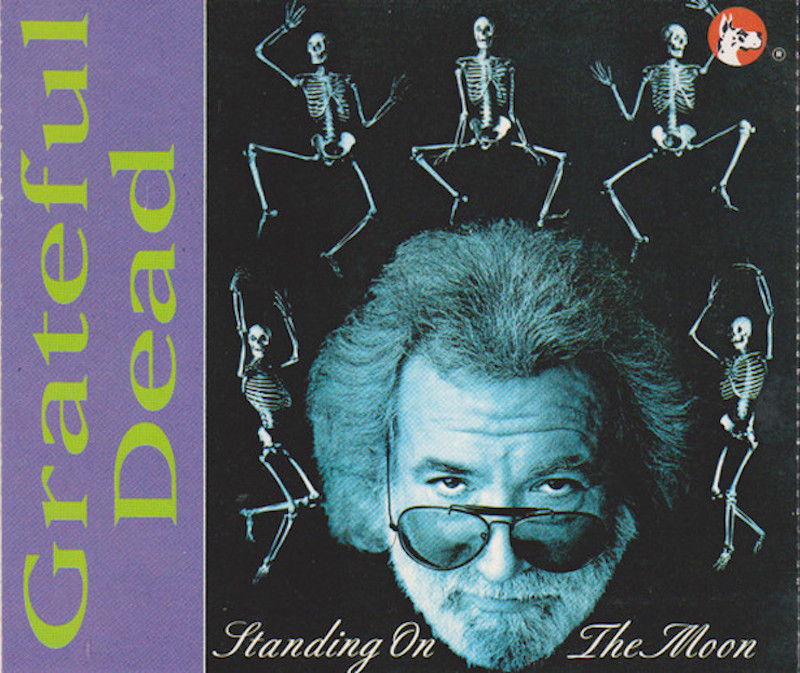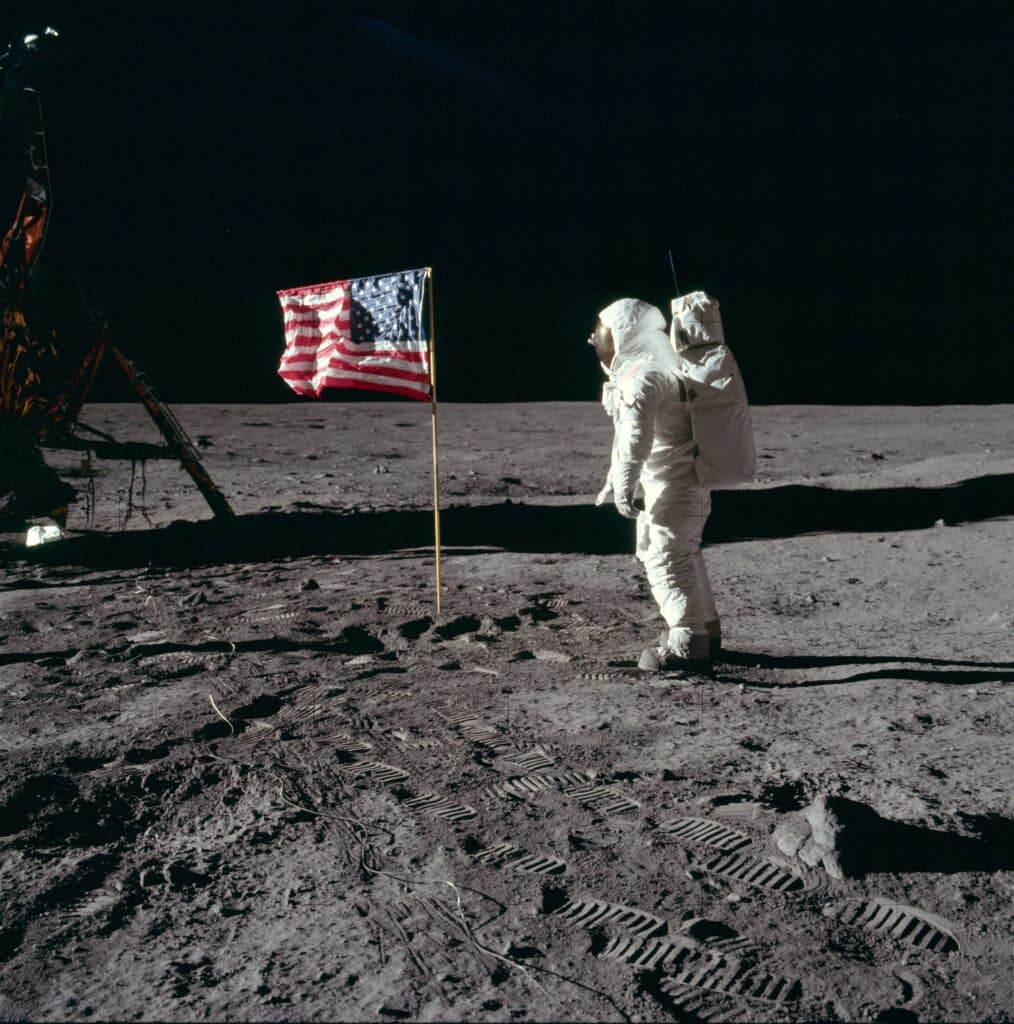The Meaning of the Grateful Dead’s “Standing on the Moon”

One of the final “Jerry Ballads” introduced to the Grateful Dead’s catalogue was “Standing on the Moon”, which entered the rotation on February 5th, 1989. Later that year it was included on the band’s thirteenth and final studio album, Built to Last.
With lyrics by Robert Hunter and music by Jerry Garcia, “Standing on the Moon” represents a latter day collaboration between the pair, showing that they still had the guts to create a powerful song, even after all the challenges that the band, and specifically Garcia, had faced in the 80s.
The slow-burning track depicts a lonely astronaut, observing the Earth from his perch upon the moon. He sees the vast beauties and troubles of the world, and despite being aware of the beautiful and special place where he stands, he longs for connection, and repeats that he’d rather be on Earth to enjoy the time he has left with his loved ones.
“Standing on the Moon” not only encompasses a universal love for the world, it can also be interpreted to represent the detachment that Garcia felt from society during this time period, and a longing for a peaceful, less complicated time from long ago.
The Grateful Dead had snowballed into something much larger than the sum of its parts beginning with the release of “Touch of Grey” in 1987, their only number one hit. In this way, the song becomes simply an anthem of detachment, but love nonetheless.
Given its slow, drawn-out nature, “Standing on the Moon” also allowed for some truly breathtaking performances by Garcia in the final years of the Grateful Dead. This was a tough time for the musician, but when he found a spark of creativity on a slow song, the magic that everybody knew existed would show itself once again. “Standing on the Moon” is beloved for providing Garcia with that space.
“Standing on the Moon” Lyrics Meaning
Lyrically, the song begins a series of verses by repeating the title phrase, “Standing on the Moon”, as Garcia sings about his circumstances and observations. The imagery is quite vivid and it becomes easy to picture Garcia perched up there, looking at the world and musing upon it.
Let’s dive in, starting with the first verse:
Standing on the moon
First verse to “Standing on the Moon” by the Grateful Dead.
I got no cobweb on my shoe
Standing on the moon
I’m feeling so alone and blue
I see the Gulf of Mexico
As tiny as a tear
The coast of California
Must be somewhere over here, over here
Our narrator is on the moon, and he’s completely alone. His shoes don’t have cobwebs, which is an abstract image but it seems to draw upon the weight of his position, as there is not even a single insect up there to keep him company.
Looking down at the Earth, he first notices the Gulf of Mexico, and in his solemn condition he notices that it resembles a tear. Then, Garcia searches for his home, the coast of California, presenting us with a nostalgic feeling that ties itself into the greater universe of the Grateful Dead — something that Hunter was apt to do.
Next, we hear some musings upon war and the state of society:
Standing on the moon
Second verse to “Standing on the Moon” by the Grateful Dead.
I see the battle rage below
Standing on the moon
I see the soldiers come and go
There’s a metal flag beside me
Someone planted long ago
Old Glory standing stiffly
Crimson, white and indigo
Old Glory standing stiffly
Crimson, white and indigo – indigo
In addition to seeing the beauties of the world, Garcia also notices the nasty parts of the world from his vantage point on the moon. He sees the armies bustle about, while he stands beside an American flag set there during the moon landings in the 1960s.

Not only does this create a vivid image of American history, it also harkens back to the band’s early days, as they were getting started in the mid-1960s, contributing to arguably the largest cultural revolution to take place in America since its inception.
The next section of lyrics brings some specific references to the table, further examining the state of the world, and subtly bringing to mind the role played by the United States:
I see all of Southeast Asia
Third verse to “Standing on the Moon” by the Grateful Dead.
I can see El Salvador
I hear the cries of children
And the other songs of war
It’s like a mighty melody
That rings down from the sky
Standing here upon the moon
I watch it all roll by, all roll by
All roll by, all roll by
As noted in the Annotated Grateful Dead Lyrics, it is likely that Hunter was referencing real world conflicts that were taking place around this time. Specifically, the Central American Wars of the 1980s, which were supported by none other than the USA.
He can hear the desperate cries of children as they grow up surrounded by war, and the booming melody drowns out all the other sounds so that it’s all he can hear from space.
Garcia can do nothing, as he is detached from it all, so he lets it all roll by while just singing about it and playing his guitar. An argument can be made that by doing just that, he made more of an impact on world peace than he could have possibly known.
When performing the song live, the repetition of the “All roll by” lyric begins to build tension for the eventual release that comes along with an often-spectacular guitar solo at the end of the song.
First, we are presented with more observations from outer space:
Standing on the moon
Fourth verse to “Standing on the Moon” by the Grateful Dead.
I see a shadow on the sun
Standing on the moon
The stars go fading one by one
I hear a cry of victory
And another of defeat
A scrap of age-old lullaby
Down some forgotten street
Here, we can see the shadow the moon casts upon the sun, and how it lasts as the stars around him burn out one by one. This depicts an exaggerated view of a loneliness that never ends, and even the inanimate objects in the sky fade away while you remain perched up there alone.
While the stars fade away, we can still hear the endless cries of war, suggesting that the struggles of humanity will outlast the universe. This paints a bleak picture of the future, and points out that humans have been at war since the beginning of time, and show no signs of stopping.
The verse closes with a lyric that calls to mind another ballad in the Grateful Dead catalogue, one that is much older — “Stella Blue”, which contains imagery about the wind crying down a every lonely street that’s ever been.
Again, this points to the thematic interconnectedness between Grateful Dead songs, as well as Hunter’s commentary upon human nature and the world around him.
The next section of lyrics reveal more of the narrator’s personal feelings:
Standing on the moon
Fifth verse to “Standing on the Moon” by the Grateful Dead.
Where talk is cheap and vision true
Standing on the moon
But I would rather be with you
Somewhere in San Francisco
On a back porch in July
Just looking up at heaven
At this crescent in the sky, in the sky
Talk is cheap on the moon because there’s nobody to talk to, so nothing you say matters. However, as we’ve heard throughout the lyrics, the view from on the moon is quite clear, as you have a bird’s eye perspective on everything happening.
Then, Jerry shows himself again, with nostalgia for summertime in San Francisco. Rather than being on the moon, he’d prefer to be back down there with his friends and family, looking up at the moon together.
The tension builds even more here, as he repeats the final line about the crescent in the sky, before we reach the final section of lyrics before the guitar solo:
Standing on the moon
Sixth verse to “Standing on the Moon” by the Grateful Dead.
With nothing left to do
A lovely view of heaven
But I’d rather be with you
A lovely view of heaven
But I’d rather be with you, be with you
He’s run out of things to keep him busy, so all he can do is look down upon the Earth and wish that he was down there. He appreciates the view of heaven, and is aware of his close proximity to it, but still longs for connection with other humans.
This line is repeated as many times as Garcia feels fit here as he unleashes the tension he has slowly built throughout the song into one majestic guitar solo to close things out.
Listen to the Built to Last version of “Standing on the Moon” below, and check out some great live versions below that.
Notable Live Versions
“Standing on the Moon” (7/7/89)
“Standing on the Moon” (7/17/89)
“Standing on the Moon” (7/6/90)
“Standing on the Moon” (8/21/93)
“Standing on the Moon” (6/30/95)
The final performance of the song came on June 30th, 1995, just over one week before the band’s final concert and about a month and a half before the death of Jerry Garcia. As you can hear on this version, Jerry still manages to induce the magic with his dying cries.
“Standing on the Moon” Covers
While it hasn’t been covered quite as many times as many other Grateful Dead songs, there are a few notable versions of the song from artists other than Garcia — even other members of the Dead. Bob Weir himself has taken up the song both in his solo tours and his tours with Dead & Company, and it’s slow pace lends itself quite well to the aging road dog.
Bobby Weir and Rat Dog – “Standing on the Moon” (8/9/05)
Fare Thee Well – “Standing on the Moon” (7/4/15)
Trey Anastasio of Phish on lead vocals and guitar here.
Dead & Company – “Standing on the Moon” (7/30/16)
Note the above version features John Mayer on lead vocals, though many later year Dead & Co versions do feature Bobby singing lead.